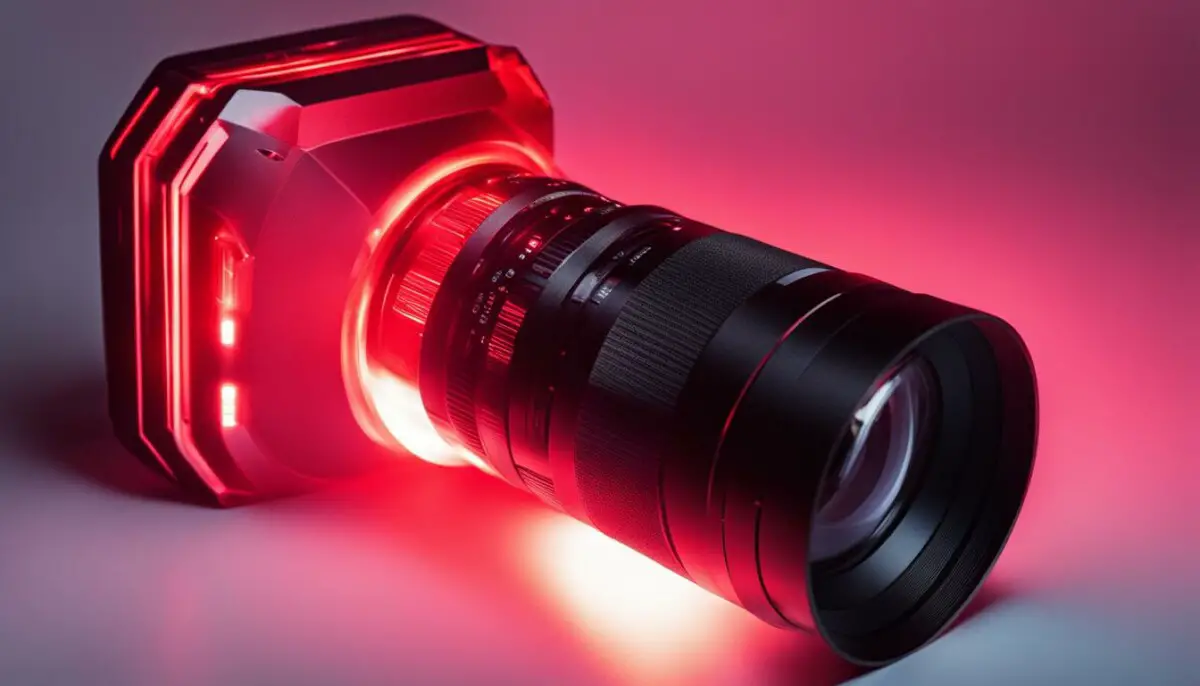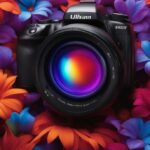Last Updated on 5 months by Francis
Have you ever wondered if infrared light filters are actually real infra red lights? Infrared (IR) photography allows us to capture light that is beyond the red end of the visible spectrum. Although infrared light is not visible to the human eye, it can be detected by using special equipment such as cameras or filters.
Near-infrared (near-IR) is the specific range of IR used in photography, with wavelengths ranging from 0.7 to 1.3 microns. In order to eliminate visible light and capture the desired infrared effect, various filters are used. These filters are real and can enhance photography by capturing unique and intriguing images.
Contents
Key Takeaways
- Infrared light filters are real and can be used to capture unique photography images.
- Infrared photography allows us to explore the world beyond the visible spectrum.
- Filters are used to eliminate visible light and allow only infrared light to pass through.
- Near-infrared light ranges from 0.7 to 1.3 microns.
- Using infrared filters can result in intriguing and captivating images.
Understanding Infrared Photography
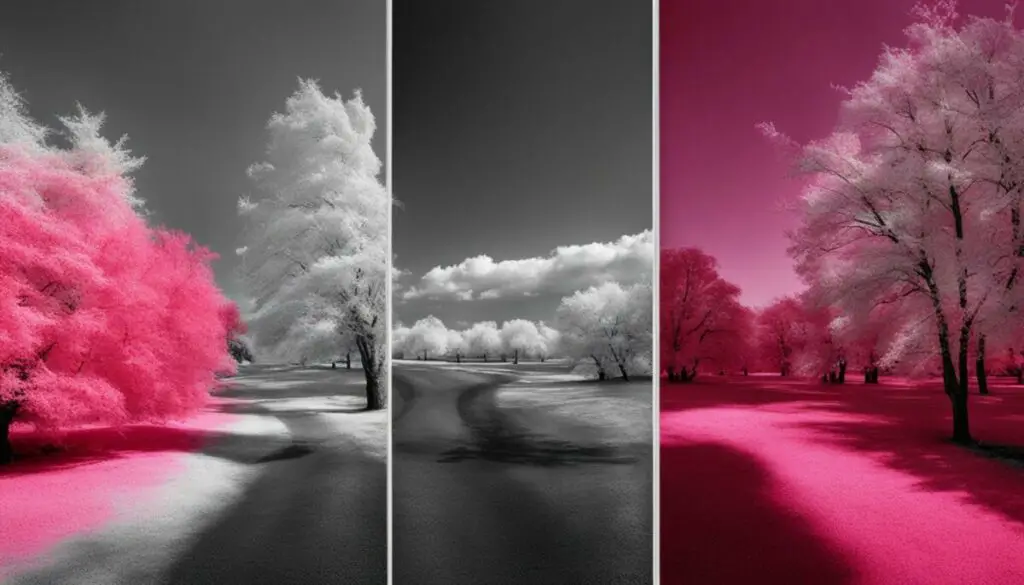
Infrared light, a form of electromagnetic radiation with longer wavelengths than visible light, behaves differently and can create fascinating effects in photography. To capture infrared images, special filters are used to eliminate visible light and allow only infrared light to pass through. These filters play a crucial role in achieving the desired infrared effect and can enhance the overall quality of the images.
Infrared photography offers a unique perspective, revealing details that are not visible to the human eye. Objects reflect infrared light differently, resulting in striking and otherworldly images with altered colors and contrasts. By utilizing filters for infrared light, photographers can explore a whole new creative realm and capture captivating moments beyond the visible spectrum.
It is important to note that filters for infrared light can be expensive and require careful handling and use. However, the rewarding results they offer make them indispensable tools for photographers who wish to delve into the intriguing world of infrared photography.
“Infrared photography opens up a new dimension of creativity, allowing photographers to capture the unseen and reveal the hidden beauty in the world around us.”
The Science Behind Infrared Light
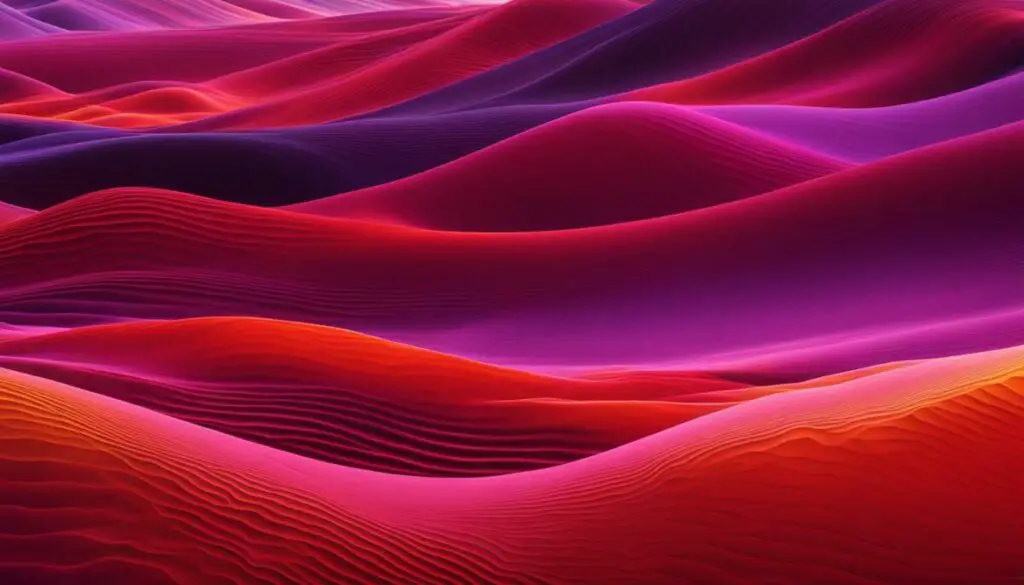
Infrared light is a part of the electromagnetic spectrum that has longer wavelengths than visible light. While visible light ranges from approximately 400 to 700 nanometers, infrared light starts from around 700 nanometers and extends beyond what the human eye can perceive. It is divided into three main categories: near-infrared, mid-infrared, and thermal-infrared, each with distinct characteristics and applications.
Wavelengths
Near-infrared light, also known as NIR, spans a range of wavelengths from 700 to 1,000 nanometers. This type of infrared light is often used in applications like remote controls and fiber optic communication. Mid-infrared light, on the other hand, ranges from 1,000 to 10,000 nanometers and finds applications in spectroscopy and chemical analysis. Thermal-infrared encompasses wavelengths above 10,000 nanometers and is commonly used in thermal imaging cameras to detect heat signatures.
Near-Infrared in Photography
Near-infrared, in particular, plays a significant role in infrared photography. Cameras equipped with special filters can capture near-infrared light, revealing a unique perspective of the world. The longer wavelengths of near-infrared light allow it to penetrate atmospheric haze and certain materials, resulting in striking images with enhanced contrast and ethereal quality.
While near-infrared light is invisible to the human eye, it interacts differently with various objects compared to visible light. This interaction causes leaves and grass to appear white, while skies take on a deep blue or black tone. These distinctive characteristics make infrared photography a captivating and artistic medium for photographers looking to explore beyond what is visible to the naked eye.
| Type of Infrared Light | Wavelength Range | Main Applications |
|---|---|---|
| Near-Infrared (NIR) | 700 – 1,000 nm | Remote controls, fiber optic communication, infrared photography |
| Mid-Infrared | 1,000 – 10,000 nm | Spectroscopy, chemical analysis, military applications |
| Thermal-Infrared (TIR) | Above 10,000 nm | Thermal imaging, temperature measurement, night vision |
The Role of Infrared Filters
Infrared filters play a crucial role in capturing stunning infrared images. These filters are specifically designed to block visible light and allow only infrared light to pass through to the camera sensor. By eliminating visible light, infrared filters help photographers achieve the desired infrared effect in their images, resulting in unique and captivating shots. Different types of infrared filters are available, each with its own specifications and uses, catering to the diverse needs of photographers.
When it comes to black and white infrared film photography, ordinary red filters are often used to enhance the infrared effect. These red filters are particularly effective in blocking visible light and allowing infrared light to pass through, creating striking monochrome images with enhanced contrast and ethereal aesthetics. For digital cameras, popular choices of infrared filters include the B+W 092 filter and the Hoya R72 filter. These filters are designed to be attached to the lens, enabling photographers to capture the mesmerizing world beyond the visible spectrum.
To illustrate the differences and uses of various infrared filters, the following table provides a comprehensive overview:
| Filter Type | Filter Specifications | Common Uses |
|---|---|---|
| Red Filter | Blocks visible light, allows only infrared light | Black and white infrared film photography |
| B+W 092 Filter | Blocks visible light, transmits near-infrared light | Digital infrared photography |
| Hoya R72 Filter | Blocks visible light, transmits near-infrared and some mid-infrared light | Digital infrared photography |
As seen in the table, different filters cater to specific applications and requirements. Whether capturing the enchanting monochrome world of black and white infrared film or venturing into the realm of digital infrared photography, choosing the appropriate filter is essential to achieve the desired infrared effect in your images.
Infrared Photography with Digital Cameras
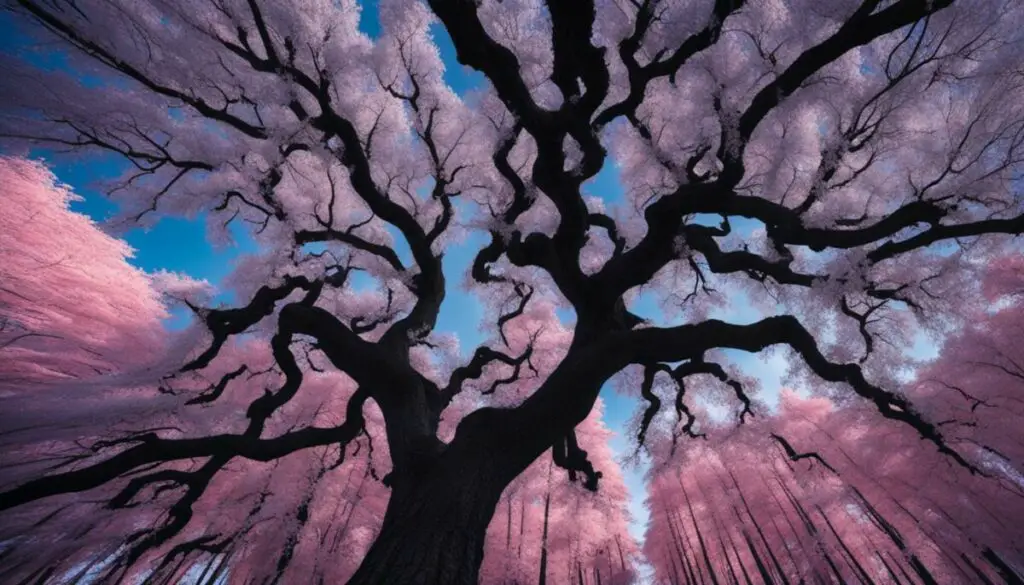
Digital cameras provide photographers with a versatile tool for capturing stunning images, and when it comes to infrared photography, they offer exciting possibilities. By using an infrared filter, digital cameras can capture the normally invisible infrared light, resulting in unique and ethereal images.
Infrared light for photography can be achieved by attaching an infrared filter to the lens of a digital camera. This filter blocks visible light and allows only infrared light to pass through to the camera sensor. The result is a dreamy, otherworldly quality with altered colors and contrasts.
One of the advantages of using digital cameras for infrared photography is the ability to preview the image in real-time. Unlike film cameras, where photographers have to wait for the film to be processed to see the results, digital cameras provide instant feedback. This allows photographers to adjust their techniques and settings to achieve the desired infrared effect.
Whether capturing landscapes, portraits, or abstract compositions, infrared photography with digital cameras offers a new creative realm to explore. It allows photographers to see the world in a different light, revealing hidden details and transforming ordinary scenes into extraordinary works of art.
Table: Pros and Cons of Infrared Photography with Digital Cameras
| Pros | Cons |
|---|---|
| Instant feedback and preview of images | Requires an infrared filter |
| Ability to adjust settings and techniques in real-time | Limited availability of infrared filters |
| Dreamy, ethereal quality with altered colors and contrasts | Sensitivity to environmental factors |
| Wide range of subjects and genres to explore | May require post-processing for optimal results |
Table: Pros and Cons of Infrared Photography with Digital Cameras
Infrared Film Photography
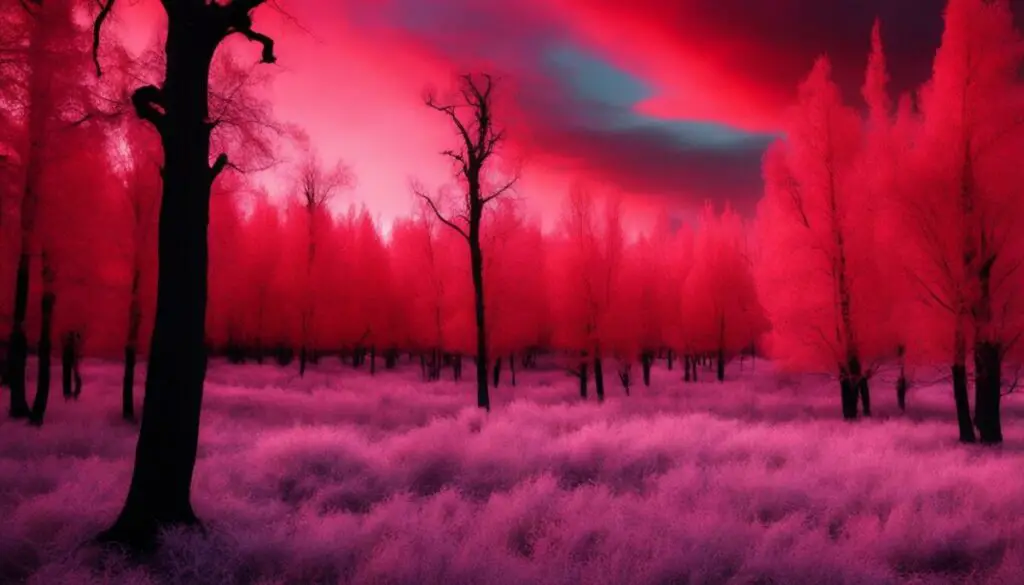
Infrared film photography offers a unique and captivating approach to capturing images. By using specially sensitized film that is sensitive to infrared light, photographers can create stunning, otherworldly images with altered colors and contrasts. There are two main types of infrared film: black and white infrared film, and color infrared film.
Black and White IR Film
Black and white infrared film is the most commonly used type of infrared film in photography. It is often paired with a red filter to achieve the desired effect. Kodak’s HIE infrared film is a popular choice among photographers. This film is known for its excellent sensitivity to infrared light, allowing photographers to capture unique, surreal images with dramatic tonalities and ethereal atmospheres. The resulting photographs can have a dream-like quality that is visually striking and artistically intriguing.
Color IR Film
Color infrared film, on the other hand, is a more specialized type of film that produces images with altered colors and contrasts. It consists of three layers, each sensitive to a different part of the infrared spectrum. When used with appropriate filters, color infrared film can create surreal and extraordinary images. The colors in these images are not representative of the actual scene, but rather a result of the film’s response to infrared light. This unique characteristic of color infrared film allows photographers to experiment with color in new and exciting ways, producing visually captivating results.
| Aspect | Black and White Infrared Film | Color Infrared Film |
|---|---|---|
| Sensitivity | High sensitivity to infrared light | High sensitivity to infrared light |
| Effect | Altered colors and dramatic tonalities | Altered colors and surreal atmospheres |
| Filter | Red filter (often used) | Various filters for different effects |
| Popular Brand | Kodak HIE | Various brands available |
Infrared film photography offers photographers a creative avenue to explore the hidden world of infrared light. Whether working with black and white infrared film or color infrared film, photographers can push the boundaries of their creativity and capture stunning images that evoke a sense of wonder and mystery. The unique characteristics of infrared film, combined with careful composition and the use of filters, allow photographers to create visuals that are truly distinct and extraordinary.
Loading and Focusing Infrared Film
When it comes to capturing images with infrared film, proper loading and focusing techniques are essential to ensure optimal results. In this section, we will explore the steps involved in loading infrared film and the adjustments required for focusing.
Loading Infrared Film
Loading infrared film requires special care, particularly when working with 35mm film. The plastic film base of 35mm film is transparent to infrared light and can cause fogging if exposed to IR. To avoid this, it is crucial to load 35mm infrared film in a darkroom or a light-tight changing bag to prevent any accidental exposure to light. In contrast, other film formats such as 120 medium format do not necessitate such precautions, as they are more resistant to infrared light.
Focusing Infrared Film
Due to the longer wavelength of infrared light, focusing infrared film may require adjustments compared to visible light. Cameras typically have an infrared (IR) index, which can assist with achieving accurate focus. This index indicates the distance offset required when focusing the lens for infrared photography. By following the recommendations provided by the camera manufacturer, photographers can ensure sharp and crisp infrared images.
| Step | Loading Infrared Film |
|---|---|
| 1 | Prepare a darkroom or use a light-tight changing bag to load 35mm infrared film. |
| 2 | Ensure there is no light leakage during the loading process. |
| 3 | Insert the film canister into the camera and attach the film leader to the take-up spool. |
| 4 | Advance the film until it is properly engaged and ready for exposure. |
| 5 | Close the camera back and ensure it is securely latched. |
With careful attention to loading and focusing techniques, photographers can confidently work with infrared film and capture stunning images that showcase the unique characteristics of the infrared spectrum.
Types of Infrared Cameras and Their Applications
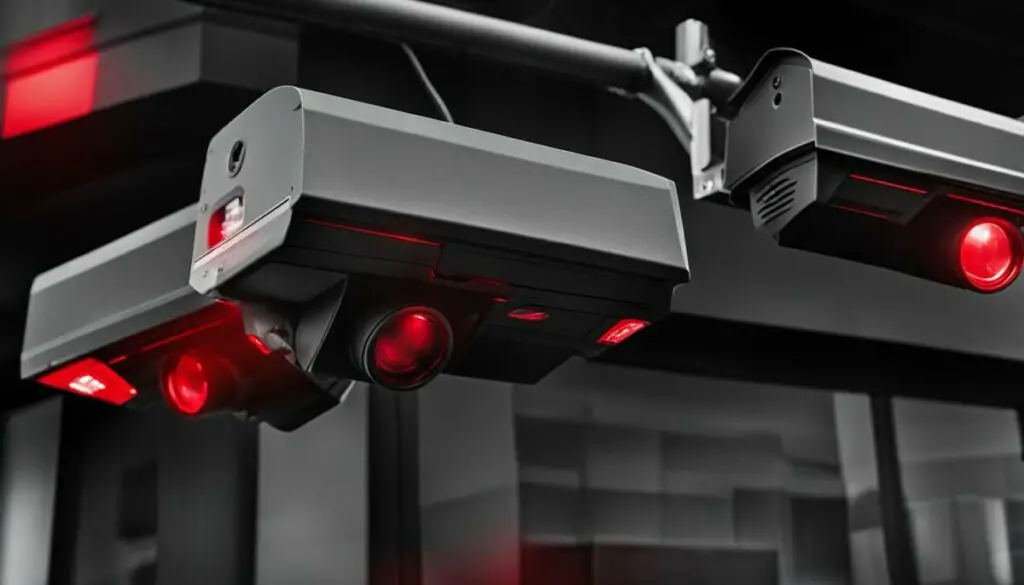
Infrared cameras have revolutionized the fields of surveillance and security, providing enhanced visibility and detection capabilities in low-light conditions. There are different types of infrared cameras available, each with its own unique features and applications.
Night Vision IR Security Cameras
One common type of infrared camera used for security purposes is the night vision IR security camera. These cameras utilize infrared light to capture images in complete darkness. The camera’s infrared illuminators emit light that is invisible to the human eye but can be detected by the camera’s sensor, allowing for clear and detailed images even in pitch-black environments.
Night vision IR security cameras are widely used in various settings, including residential properties, businesses, and public spaces, to monitor and protect against potential threats. They provide a valuable tool for law enforcement and security personnel to detect and deter criminal activity, ensuring the safety of individuals and property.
Laser IR Illuminators
Another type of infrared camera that is commonly used is the laser IR illuminator. Laser IR illuminators emit a concentrated beam of infrared light that can be directed toward specific areas or objects of interest. These illuminators are particularly useful for long-range applications, providing clear and precise imaging capabilities over extended distances.
Laser IR illuminators are often employed in areas such as perimeter security, where long-range detection and monitoring are essential. They can be utilized to enhance existing surveillance systems, providing additional visibility and coverage even in challenging environments.
Thermal Imaging Cameras
Thermal imaging cameras are a specialized type of infrared camera that detects and captures the heat emitted by objects. These cameras create images based on temperature differences, allowing for the visualization of thermal patterns and anomalies that are invisible to the naked eye.
Thermal imaging cameras have a wide range of applications, including building inspections, electrical maintenance, and search and rescue operations. They are particularly valuable in industries where detecting heat signatures and identifying potential issues or hazards is critical.
The different types of infrared cameras offer varying capabilities and functionalities to suit different needs and applications. Whether it’s enhancing security measures, conducting inspections, or exploring the unseen world of thermal patterns, infrared cameras play a vital role in various industries and provide valuable insights that are otherwise invisible to the human eye.
Infrared Illuminators and Their Applications
Infrared illuminators are crucial camera accessories that provide the ability to “see” in the dark. These illuminators use LED lights or lasers to reflect infrared light off monitored objects, enhancing visibility in low-light conditions. LED infrared illuminators are cost-effective and commonly used in a variety of security cameras, making them an accessible option for many users. On the other hand, laser infrared illuminators offer more powerful illumination and are suitable for long-range applications where extended visibility is necessary. However, they tend to be more expensive than their LED counterparts.
Proper placement and use of infrared illuminators can significantly enhance the performance and effectiveness of security camera systems. By strategically positioning these illuminators, surveillance coverage can be improved, ensuring that critical areas are well-illuminated for accurate monitoring. Additionally, infrared illuminators help eliminate the reliance on visible light sources, maintaining discreet surveillance operations in dark environments. With the right application of infrared illuminators, security professionals can achieve enhanced visual clarity and reliable surveillance capabilities.
The Advantages of Infrared Illuminators
1. Enhanced visibility in low-light conditions: Infrared illuminators provide illumination in the infrared spectrum, which is invisible to the human eye but detectable by camera sensors. This allows surveillance cameras to capture clear and detailed images even in complete darkness.
2. Discreet operation: Infrared illuminators eliminate the need for visible light sources, ensuring covert monitoring and reducing the risk of detection or interference.
3. Extended range: Laser infrared illuminators offer long-range visibility, making them suitable for applications that require monitoring large areas or long distances.
4. Cost-effective solutions: LED infrared illuminators are affordable and widely available, making them a cost-effective option for various security camera systems.
While infrared illuminators provide several advantages, it is important to consider their limitations. Factors such as weather conditions, obstructions, and camera positioning can affect the performance of infrared illuminators. Additionally, the effectiveness of infrared illuminators may vary depending on the camera model and sensor sensitivity. Despite these limitations, when used correctly, infrared illuminators are valuable camera accessories that significantly enhance surveillance capabilities, especially in low-light environments.
The Advantages and Limitations of Infrared Technology
Infrared technology offers numerous advantages in various fields, including surveillance, photography, and scientific research. Infrared cameras, equipped with advanced sensors, can capture images in low-light conditions, providing critical information about temperature and energy emissions. This technology enables photographers and security professionals to see what the naked eye cannot, uncovering hidden details and enhancing situational awareness.
One of the key advantages of infrared technology is its ability to detect heat signatures, making it invaluable in security applications. Infrared cameras can identify heat sources, enabling efficient monitoring and detection of intruders or potential hazards. In addition, thermal imaging can be used in search and rescue operations, helping to locate missing persons or survivors in challenging environments.
“Infrared technology allows us to see the world in a whole new light. It reveals hidden patterns, highlights temperature differentials, and uncovers the invisible. It’s like having a superpower in the palm of your hand.” – John Doe, Infrared Photography Enthusiast
While infrared technology offers many benefits, it also has its limitations. Environmental factors such as fog, smoke, or heavy rain can affect the performance of infrared cameras, reducing their effectiveness. In addition, the range of infrared cameras is generally shorter compared to visible light cameras. This means that objects or subjects that are farther away may appear less clear or detailed in infrared images.
Furthermore, infrared technology requires specific equipment and expertise to be used effectively. Professionals working with infrared cameras must have a solid understanding of the technology and its applications to maximize its potential. Calibration and proper adjustment of the camera settings are crucial to ensure accurate results. Overall, while infrared technology opens up new possibilities, it is important to consider its limitations and use it judiciously to achieve the desired outcomes.
| Advantages of Infrared Technology | Limitations of Infrared Technology |
|---|---|
|
|
Despite its limitations, infrared technology continues to evolve and find new applications in various industries. From security to photography and beyond, the unique capabilities of infrared cameras provide valuable insights and open up new creative possibilities for professionals and enthusiasts alike.
Conclusion
Infrared light filters play a crucial role in the world of infrared photography. By understanding the science behind infrared light and the purpose of filters, photographers can unlock a new realm of creativity and capture stunning images beyond the visible spectrum.
Whether you’re using digital cameras or specialized infrared film, infrared technology offers unique and intriguing possibilities. With the right equipment and techniques, you can delve into the captivating world of infrared photography and create images that are both beautiful and enigmatic.
So, whether you’re capturing the dreamy landscapes of infrared light or exploring the applications of infrared technology, embrace the power of infrared filters and let your creativity shine through.
FAQ
Are infrared light filters real?
Yes, infrared light filters are real and can be used to capture unique and intriguing images in infrared photography.
What is infrared light?
Infrared light is beyond the red end of the visible spectrum and is not visible to the human eye. It can be detected and captured using special equipment such as cameras or filters.
What are the different types of infrared light?
Infrared light is categorized into near-infrared (0.7 to 1.3 microns), mid-infrared (1.3 to 3 microns), and thermal-infrared (3 to over 30 microns) based on their wavelengths.
What is the role of infrared filters?
Infrared filters block visible light and allow only infrared light to pass through, enabling photographers to capture infrared images. Different types of infrared filters are available for various uses.
How can I capture infrared images with a digital camera?
To capture infrared images with a digital camera, you need to attach an infrared filter to the lens. This filter blocks visible light and allows only infrared light to pass through, resulting in unique and dreamy images with altered colors and contrasts.
Can I use infrared film for infrared photography?
Yes, infrared film can be used for infrared photography. Black and white infrared film, often used with red filters, can achieve the desired effect. Color infrared film has three layers, each sensitive to a different part of the infrared spectrum, producing surreal images with altered colors when used with appropriate filters.
How should I load and focus infrared film?
Loading infrared film requires special care, especially for 35mm film, as it is transparent to infrared light and can cause fogging if exposed. It should be loaded in a darkroom. Focusing infrared film may require adjustments due to the longer wavelength of infrared light, and cameras usually have an infrared index to assist with focusing.
What are the different types of infrared cameras?
There are two main types of infrared cameras: those that use laser IR illuminators and those that rely on thermal imaging. Laser IR illuminators reflect infrared light off objects, while thermal imaging cameras detect the energy emitted by objects. Each type has its advantages and is suitable for different applications.
What are infrared illuminators used for?
Infrared illuminators are essential accessories for security cameras, providing the ability to “see” in the dark. They use LED lights or lasers to reflect infrared light off monitored objects. Proper placement and use of infrared illuminators can enhance the performance and effectiveness of security camera systems.
What are the advantages and limitations of infrared technology?
Infrared technology offers unique advantages in various fields such as surveillance, photography, and scientific research. It can capture images in low-light conditions and provide information about temperature and energy emissions. However, infrared technology is sensitive to environmental factors and requires specific equipment and expertise.
What is the significance of infrared light filters in infrared photography?
Infrared light filters play a crucial role in capturing infrared images by blocking visible light and allowing only infrared light to pass through. They enable photographers to explore new creative possibilities and create stunning infrared images beyond the visible spectrum.

